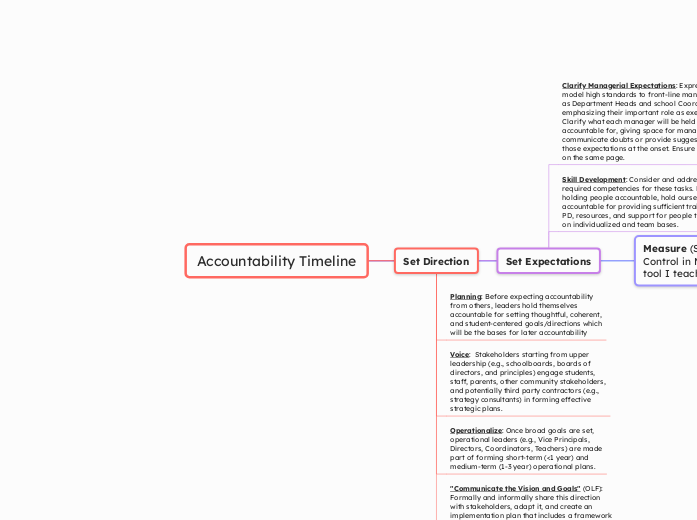Accountability Timeline
Set Direction
Planning: Before expecting accountability
from others, leaders hold themselves
accountable for setting thoughtful, coherent,
and student-centered goals/directions which
will be the bases for later accountability
Voice: Stakeholders starting from upper
leadership (e.g., schoolboards, boards of
directors, and principles) engage students,
staff, parents, other community stakeholders,
and potentially third party contractors (e.g.,
strategy consultants) in forming effective
strategic plans.
Operationalize: Once broad goals are set,
operational leaders (e.g., Vice Principals,
Directors, Coordinators, Teachers) are made
part of forming short-term (<1 year) and
medium-term (1-3 year) operational plans.
"Communicate the Vision and Goals" (OLF):
Formally and informally share this direction
with stakeholders, adapt it, and create an
implementation plan that includes a framework
for measuring its progress.
Set Expectations
Clarify Managerial Expectations: Express and
model high standards to front-line managers. such as Department Heads and school Coordinators,
emphasizing their important role as executors.
Clarify what each manager will be held accountable for, giving space for managers to communicate doubts or provide suggestions about those expectations at the onset. Ensure everyone is on the same page.
Skill Development: Consider and address the
required competencies for these tasks. Before
holding people accountable, hold ourselves
accountable for providing sufficient training,
PD, resources, and support for people to succeed
on individualized and team bases.
Measure (Sourced from 4 Stages of Control in Management Theory - a tool I teach in BOH4M)
Input and Output Standards: Define input and output standards. For example, if the direction is to improve reading skills, input standards might include measuring the amount of meeting time each department has spent collaborating about subject-specific literacy, whereas output standards might involve measuring improvement on reading assessments.
Ensure Validity and Reliability of Metrics: Similar to a teacher grading an essay and ensuring the rubric is valid (it measures what it's meant to) and reliable (different teachers would use the rubric to provide similar grades to the same paper), the same should be done for a leader's measurements to hold people accountable. For example, continuing the literacy point, a leader should ask if reading assessments validly measure a student's reading ability (likely "yes"), and if the tools are designed clearly enough to minimize grade error/variance. If yes to both, this is a reasonable tool for a leader to hold others accountable based on.
Decide on Comparison Tool: Once metrics are ready, a manager should decide whether to use relative comparison (comparing reading assessment results against others), historical comparison (comparing current against past results) or engineering comparison (comparing results against some scientifically determined standard). In the case of reading assessment results and this manager's goal to "improve" student reading, historical comparison likely makes the most sense.
MBE (Management by Exception): Based on these results, a leader should approach accountability by focusing on the highest magnitude differences in actual results from expected standards. For example, instead of only supporting performers falling below standards, a leader should aim to devote time/resources to the managers or teachers who deviate furthest from expectation in either a positive or negative direction.
Learn
Manage the Manager: Peter Drucker argued the most important person to manage is a manager's self. Reflecting on the process by which you held others accountable, a leader should reflect on the process they used to set direction, to set standards, to measure, and to follow-up. Were they fair? Were they clear? Were they motivational? Did they keep students at the forefront?
Seek Feedback: Create space for structured feedback and discussion, such as surveys or devoted meeting time, to help systemically improve the process by which you held people accountable.
Follow-up / Share Blame: Since efforts were already made in the "Set Expectations" stage to collaborative establish and communicate clear expectations, individuals should be trusted as much as possible to hold themselves accountable. For example, if a teacher falls short of a goal, let them reflect on what happened. The leader should listen to this teacher, learn from their reflection, and be open to potential leadership mistakes such as lacking clarity or support. Good leaders share in the contribution to mistakes, use it to model vulnerability, and transform vulnerability into a psychologically safe learning culture.
